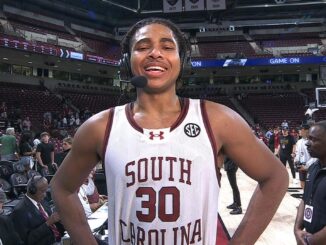
Tidjane Salaun
6’9 210 lbs Small Forward/Power Forward
18 yrs old (Born August 10, 2005)
Last played for Cholet in LNB Pro A
Salaun projects in the 2024 NBA Draft are a bit of a mystery. Scouts are drooling over his athleticism, especially in transition. His 7-1 wingspan and leaping strides make for some impressive fast-break footage. Cholet used him as a jack of all trades, running him in both positions on the pick-and-roll, calling for him as a cutter, or even as a point ball handler. His lateral mobility is above average for his size. He showed a good instinct for shot-blocking last season as well.
The downsides, however, are worrying. He has only played high-level organized basketball for a couple of years. He is certainly not a plug-and-play type player and will need a strong organizational foundation to build him up. He lacks the strength to attack the rim and use his athleticism, though his frame could handle additional muscle without too much of an injury concern. His numbers at Cholet last season were somewhat underwhelming, including just 32.9% from three. For a lack of pure ball handling, he still committed 1.5 turnovers per contest. He tends to gamble on steals and commit bad fouls. His shooting is streaky at times.
For the Portland Trail Blazers, a selection of Salaun would be a clear signal the team is taking another year off to develop their young core. His ceiling is a top 3-and-D wing that every team covets. Someone to fill in all the gaps, even if they are not the first option on offense. His floor is in the basement. It would be a big swing for a franchise desperate for a sold wing.
Cody Williams
6’8 180 lbs Small Forward/Power Forward
19 years old (Born November 20, 2004)
Last played for University of Colorado
Cody, the younger brother of Oklahoma City Thunder forward Jalen Williams, was hyped coming into the season for the Buffaloes. He was a consensus 5-star recruit and ranked at least seventh among all prospects in the 2023 class.
That hype did not necessarily translate into success in his freshman season. On the plus side, in a stretch of nine games between November 21 and January 24, he averaged 17.7 points per game. During that time, he averaged nearly two turnovers per contest and offered little else in passing or rebounding. Soon after, he missed a month of games due to a wrist injury and put up middling numbers when he returned in January before suffering an ankle injury. In the Pac-12 tournament, he averaged just six points per contest and was a non-factor for Colorado’s first two NCAA Tournament games.
His draft profile rests as much on his pedigree as his performance. When healthy, he showed flashes of being a two-way wing who can contribute, assuming he works on his three-point shot (a respectable 41.5 percent on limited shots last season). His defense was always above average, even against top competition. His floor is not as low as other prospects, with Williams projected to be at least a bench contributor. His shot is his biggest weakness, with him shooting just 74 percent from the free-throw line. He also needs to put on size so as not to get bullied on drives.
A team is going to gamble on Williams in the top 10. If Portland does, they must find out if Williams can develop a shot or suffer next to Scoot Henderson’s lack of offense.



